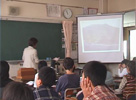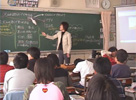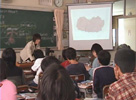
| Place |
 |
■Regular classroom □Computer
room □Special classroom □Gymnasium
□Athletic Field □Outdoors □Others〔 〕 |
 |
 |
 |
| Type
of Lesson |
 |
■Class □Group □Pair/Individual □Follow-up □Others〔 〕 |
 |
 |
 |
| Phase |
 |
■Introduction ■Development ■Conclusion □Others〔Student
Presentation〕 |
 |
 |
 |
| Main
user of IT |
 |
■Teacher □Student □Others〔 〕 |
 |
 |
 |
| Objectives |
 |
□To
introduce the topic ■To motivate students ■As illustrative material
used by the teacher □As illustrative material used by the student □To
master through repetition ■To present a model □To recollect past experiences ■To
compare □To examine what has been done/studied ■To provide second-hand
experience □Others〔 〕 |
 |
 |
 |
| Equipment |
 |
■Computer ■Projector ■Screen □Electronic
Whiteboard □Visual Presenter □Digital Camera □Video Player ■Internet ■Digital
Contents □CD-ROM □Speakers □Others〔 〕 |
|


| The use of digital contents to show video clips of volcanic activities that we are usually unable to encounter, as well as images difficult to portray just by showing geologic stratum models and/or rock samples. The object is to have the students infer from the provided visuals how the earth was formed by volcanic eruptions. |


The Formation and
Transformation of the Earth
Contents: based on MEXT’s curriculum
guidelines
6th Grade Content C The Earth and the Universe
(1)
| (B) |
| B |
The
geological stratum was formed by water activity and volcanic eruptions
and often contains fossil remains. |
|


| (1) |
The students
shall discover that geological stratums containing volcanic ashes, angular
rock pieces, and perforated stones were formed by volcanic activities.
The teacher shall help and aid the students to predict an image of how
the earth was formed by the volcanic eruptions. |


| (1) |
Look at
pictures of volcanos and examine their appearances.
|
| (2) |
Study the samples of rocks found
near volcanos, watch the digital content regarding rocks available via
the Internet, and discuss the features of the rocks found on the ground
formed by volcanic activities. |
| (3) |
Look at video clips of volcanic
eruptions, and predict how a geological stratum was formed by volcanic
activities and discuss its relation to the rocks found in the stratum.
|
| (4) |
Watch a video of a volcanic eruption
and summarize how geological stratums are formed by volcanos, creating
the earth.
|


| (1) |
The digital
content entitled "An Animation of a Volcanic Eruption", repeatedly plays the eruption scenes making it easy for students to predict
that the earth was formed by recurring volcanic eruptions. This material
is also effective when used at the end of the lesson. |
| (2) |
If actual rock specimens are available,
it is recommended to present them along with the specimens found on the
Internet. By comparing them with the rock specimens found on the ground
which was formed by water activity, the students will be able to clearly
observe the difference between the two. |


|



